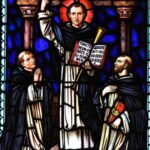St. David
St. David
When He Lived:
Saint David was born around the year 500 AD and passed away on March 1, 589 AD. His exact birthdate is not known, but he is believed to have lived during the 6th century.
Where He Lived:
Saint David spent much of his life in what is now Pembrokeshire, Wales. He founded a monastery known as “Ty Ddewi” or “St. David’s” in the western part of Wales, near the beautiful Pembrokeshire coast.
Notable World Events During His Life:
- The Fall of the Western Roman Empire (476 AD): During Saint David’s lifetime, the Western Roman Empire, which had been a major force in the Mediterranean world, fell. This event marked the transition from ancient times to the medieval period in Europe.
- The Life of King Arthur: While the exact historical nature of King Arthur is debated, he is believed to have lived during the same general period as Saint David. The legends and stories about King Arthur and the Knights of the Round Table were part of the cultural backdrop of Saint David’s time.
- Spread of Christianity: Saint David played a significant role in spreading Christianity in Wales, and his life coincided with the broader spread of the Christian faith throughout Europe during the early medieval period.
- Anglo-Saxon Migration and Kingdoms: In England, during Saint David’s time, the Anglo-Saxons were establishing their own kingdoms, leading to cultural and political changes in the region.
Patronage:
Saint David is the patron saint of Wales and is highly revered by the Welsh people. He is also the patron saint of poets, as he was known for his eloquent preaching, and his feast day, St. David’s Day, is celebrated annually on March 1st.
Saint David’s life is filled with rich history and is intertwined with the cultural and religious development of Wales. His legacy continues to be celebrated, not only by the Welsh but by all those who appreciate his contributions to Christianity and the poetic arts.
Early Life
St.David, one of the most celebrated British saints, was born in 520 AD. It is said that his birth was foretold by an angel to Saint Patrick around 373 AD.
The circumstances surrounding the birth of David are sketchy. His mother was called Non, who might have been a nun at the cloister in Ty Gwyn at the time. Non, who later became Saint Non, was also the daughter of a king in Pembrokeshire.
It was also said that his father, Sant, also known as Xantus, was a local king who was related to King Arthur. It is stated that Sant raped Non because she was very beautiful.
Another legend has it that Sant and Non were married, and Non became a nun later in her life. She conceived a child and gave birth to David at a place close to St. Bride’s Bay.
Saint David was baptized around Porth Clais by Saint Ailbhe. It is said that miracles happened on that day, one of which involved a monk who was blind regaining his sight.
Dedication and Devotion
St. David began schooling at Hen Vynywa monastery in Cardigan. It is said that David learned Latin, astronomy, and Mathematics there. Upon completing his studies at Hen Vynyw, it is said that David went on to continue his studies on the Isle of Wight to become a priest. Saint Paulinus was his teacher.
St. David was a vegetarian and ate only vegetables, herbs, and bread. He only drank water, no wine. Sometimes he went to the cold lake, his body dipping up to his neck as he recited scriptures. This was his penance.
News spread about St.David and the monks. Their dedication was unrivaled. They worked under difficult circumstances. They limited their food to vegetables and bread and tilled the land themselves without the use of animals.
Life at the monastery was strict. The monks ate once a day, in the evening, after which they prayed for three hours before going to sleep. Speech was limited; they were to pray at all times.
The monks fed themselves and the visitors that came around. They also learned bookkeeping and fed the poor.
Legacy
- He insisted on this path, following the moral decadence he observed.
at the time.
Death and Canonization
David died in his monastery at an old age. The year he died is not known, but it is said to be between 560 and 601.
In 1120, Pope Callactus II canonized David as a Saint.
5 Interesting Facts About St. David
- Did you know that St. David is the patron saint of doves, poets, and
Wales? - Did you know that St. David was known as Aquaticus (which means the
water drinker) in Welsh? - Did you know that anyone who wanted to join Saint David’s monastery
has to wait outside for 10 days? - Did you know that St. David’s Cathedral is Wales’s largest
cathedral? - Did you know that more than fifty churches in South Wales were
dedicated to St. David in pre-reformation days?
Prayer to St. David
God our Father, you gave the bishop David to the Welsh Church to uphold the faith and be an example of Christian perfection. In this changing world, may he help us to hold fast to the values that bring eternal life. Through our Lord Jesus Christ, your Son, who lives and reigns with you in the unity of the Holy Spirit, one God, for ever and ever Amen.
Reference
[https://www.historic-uk.com/HistoryUK/HistoryofWales/St-David-Patron-Saint-of-Wales/]{.ul}
https://www.franciscanmedia.org/saint-of-the-day/saint-david-of-wales



